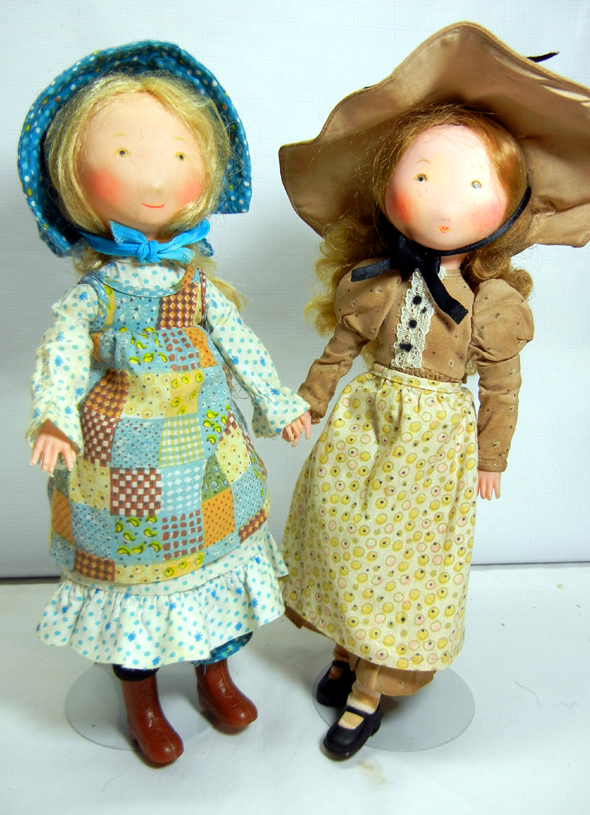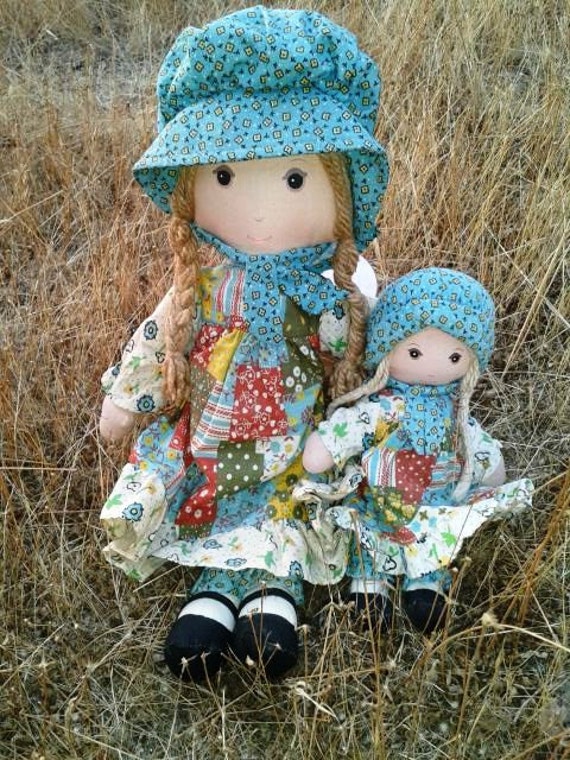In a world often captivated by glitz, glamour, and the latest trends, there exists a timeless appeal in simplicity, kindness, and a touch of homespun charm. For over five decades, one character has embodied these gentle virtues, captivating hearts with her bonnet, calico dresses, and a spirit as warm as a sun-drenched meadow: Holly Hobbie. More than just a greeting card illustration, Holly Hobbie blossomed into a cultural phenomenon, most notably through her iconic line of dolls. These soft, wholesome figures offered a comforting counterpoint to the fashion-forward dolls of their era, etching themselves into the collective memory as symbols of innocence, friendship, and a cherished, simpler way of life.
The Genesis of a Gentle Icon: From Card to Character
The story of Holly Hobbie begins not with a doll, but with the distinctive artwork of Denise Holly Hobbie (later Ulinskas). In the late 1960s, working as a freelance artist for American Greetings, Hobbie began sketching charming illustrations of a bonneted girl, often accompanied by a cat or other animals, engaged in idyllic country activities. These designs, characterized by their muted color palette, intricate detailing, and heartwarming messages, quickly resonated with the public. They offered a refreshing escape from the vibrant, often psychedelic aesthetics of the time, harking back to a romanticized vision of rural Americana and Victorian sentimentality.
The popularity of these greeting cards was undeniable. Consumers were drawn to the wholesome imagery and the underlying themes of friendship, family, and simple joys. It wasn’t long before American Greetings recognized the potential to expand Holly Hobbie beyond paper products. The character, though initially unnamed, had developed a distinct personality through her visual storytelling – a quiet, observant, and kind-hearted girl. This natural progression led to the first merchandise, laying the groundwork for what would become one of the most beloved doll lines of the 1970s.
The Knickerbocker Era: Bringing Holly to Life
The true leap from two-dimensional art to three-dimensional companionship occurred when Knickerbocker Toy Company acquired the license to produce Holly Hobbie dolls. In 1975, the first Holly Hobbie rag dolls hit the market, and their success was instantaneous and monumental. These dolls were a revelation, offering something distinctly different from the highly stylized, plastic fashion dolls that dominated the toy aisles.
Knickerbocker’s Holly Hobbie dolls were characterized by their soft, cloth bodies, often filled with beans or pellets, making them wonderfully huggable and posable. Their faces were gently embroidered or screen-printed, featuring large, innocent eyes and a subtle smile. But it was their distinctive attire that truly defined them: meticulously crafted calico dresses, often adorned with patches, lace, and ruffles, topped with the ubiquitous wide-brimmed bonnet that famously obscured most of their face, inviting children to imagine her expressions. Yarn hair, usually blonde or brown, peeked out from beneath the bonnet, adding to their homespun charm.
The dolls came in various sizes, from small collectible figures to larger "life-size" companions. Each doll was a testament to quality and attention to detail, reflecting the wholesome aesthetic of Denise Holly Hobbie’s original artwork. They quickly became a must-have toy, not just for girls, but for anyone who appreciated their comforting presence. Knickerbocker further expanded the line, introducing Holly’s friends: Amy, Heather, and Carrie, each with their own unique patchwork outfits and bonnets, fostering themes of camaraderie and shared adventures. There was even a boy character, Robbie, ensuring that the world of Holly Hobbie was inclusive and reflective of a broader community.
The marketing of Holly Hobbie dolls emphasized friendship, imagination, and the simple pleasures of childhood. They weren’t about high fashion or aspirational glamour; they were about quiet companionship, tea parties, storytelling, and the warmth of a homemade quilt. This resonated deeply with parents and children alike, who found in Holly a gentle spirit that encouraged kindness and imaginative play over consumerism and materialism.
A World of Wholesome Wonders: The Extended Holly Hobbie Universe
The phenomenal success of the dolls propelled Holly Hobbie into a full-fledged lifestyle brand. Her image adorned an incredible array of merchandise, transforming homes and wardrobes with her signature style. Children could sleep under Holly Hobbie bedspreads, eat breakfast from Holly Hobbie plates, carry Holly Hobbie lunchboxes, and fill their rooms with Holly Hobbie stationery, books, and figurines. Adult collectors also found joy in the nostalgic kitchenware, decorative tins, and sewing accessories.
Every item in the Holly Hobbie universe maintained a consistent aesthetic and thematic message. The designs evoked a sense of comfort, warmth, and nostalgia for a simpler, idealized rural life. Patchwork, gingham, and calico patterns became synonymous with the brand, creating a visual language that spoke of homemade crafts, rustic charm, and enduring values.
Beyond tangible goods, Holly Hobbie’s world expanded into media. Early animated television specials brought her and her friends to life, further cementing her personality and the gentle narratives associated with her. These adaptations carefully preserved the wholesome, heartfelt essence of the original artwork, introducing her stories to a new generation through a different medium.
Enduring Appeal and Cultural Significance
The enduring appeal of Holly Hobbie dolls and her associated brand lies in several key factors that transcend mere trends:
- Nostalgia for Simplicity: In an increasingly complex and fast-paced world, Holly Hobbie offered, and continues to offer, a comforting retreat into a romanticized past. She evokes a longing for simpler times, where community, nature, and handmade items held greater prominence.
- Wholesome Values: Holly Hobbie is a paragon of innocence, kindness, and friendship. Her image is devoid of pretense or overt materialism, presenting a refreshing alternative to dolls that often emphasized glamour or adult roles. She teaches children about the value of inner beauty and genuine connection.
- A Counter-Narrative: During the 1970s and 80s, when dolls like Barbie were dominating with their fashion-forward, aspirational imagery, Holly Hobbie provided a gentle counter-narrative. She wasn’t about career aspirations or societal expectations of beauty; she was about being present, kind, and finding joy in everyday moments. This offered parents an alternative that aligned with more traditional or wholesome values they wished to instill.
- Emotional Connection: The soft, huggable nature of the dolls, combined with their unassuming expressions, fostered a deep emotional connection with children. They were companions, confidantes, and silent witnesses to countless childhood adventures. The bonnet, while concealing her face, paradoxically made her more relatable, allowing children to project their own emotions and narratives onto her.
- Intergenerational Appeal: Many adults who grew up with Holly Hobbie dolls now share their cherished memories and even their vintage dolls with their own children or grandchildren. This creates a powerful intergenerational bond, passing down not just a toy, but a set of values and a shared sense of nostalgia.
Evolution and Reboots: Adapting to New Generations
While the original Knickerbocker dolls enjoyed immense popularity throughout the 1970s and early 80s, changing toy trends and the rise of new characters led to a decline in their market dominance. However, the gentle spirit of Holly Hobbie was too potent to fade entirely.
Throughout the years, various companies have attempted to revive the brand for new generations. Mattel, for instance, produced a line of Holly Hobbie dolls in the early 2000s, giving her a slightly modernized look while striving to retain her core charm. These dolls featured more contemporary fabrics and slightly different facial sculpts, reflecting updated aesthetics.
More recently, the character has seen a significant reboot with new animated series, such as "Holly Hobbie" (2018), which reimagines her as a contemporary, guitar-playing singer-songwriter and community activist. These modern interpretations aim to introduce Holly Hobbie’s core values of kindness, creativity, and standing up for what’s right to a generation familiar with streaming platforms and social media, while still nodding to her classic, homespun origins. The challenge lies in balancing modernization with the preservation of the gentle, nostalgic essence that made her beloved in the first place.
Collecting Holly Hobbie: A Cherished Pursuit
Today, vintage Holly Hobbie dolls and merchandise remain highly sought after by collectors. The original Knickerbocker dolls, particularly those in good condition with their complete original outfits, can fetch significant prices. Collectors value the craftsmanship, the nostalgic appeal, and the tangible connection to a beloved era. Online marketplaces, specialized toy conventions, and antique shops are vibrant hubs for those seeking to complete their collections or simply rediscover a piece of their childhood.
Beyond monetary value, collecting Holly Hobbie is often a deeply personal endeavor. Each doll, each piece of stationery, each decorative tin, carries with it a whisper of cherished memories and a tangible link to a simpler time. It’s a pursuit driven by affection, nostalgia, and a desire to preserve a piece of cultural history that continues to bring comfort and joy.
Conclusion
From a humble greeting card illustration to an iconic doll and a multifaceted lifestyle brand, Holly Hobbie’s journey is a testament to the enduring power of gentle virtues. Her bonneted figure, clad in patchwork calico, stands as a timeless symbol of innocence, friendship, and the comforting allure of a simpler world. In an ever-changing landscape, the gentle spirit of Holly Hobbie continues to resonate, reminding us of the beauty in kindness, the strength in community, and the quiet magic found in the everyday. She is more than just a doll; she is a cherished emblem of a heartwarming ideal, forever inviting us to embrace a world where simple joys are the most profound.


